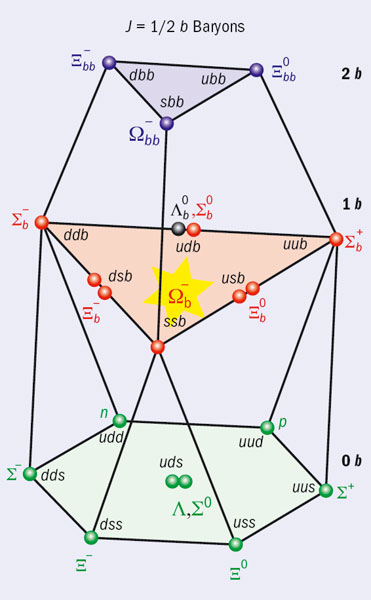The D0 collaboration at Fermilab’s Tevatron has made the first observation of the Ωb, consisting of two s quarks and a b quark. This follows the discovery at Fermilab of the strange b baryon, Ξb, in 2007, and echoes that of the original Ω– particle.

The prediction of the original Ω– dates back to the early 1960s, when assigning the known baryons to symmetry groups according to properties including spin, isospin and strangeness hinted at the existence of a new, triply strange spin–3/2 baryon with a charge of –1. In a triumphant interplay between experiment and theory, the particle was discovered in 1964 in a photograph made at the 80 inch bubble chamber at Brookhaven National Laboratory. Subsequent events turned up soon after at CERN. The success of the symmetry group structure led to the quark model, with three initial types or “flavours” of quark, u, d, and s, where the s quark endows the property of strangeness. The Ω– is a baryon, consisting of three quarks, sss.

The subsequent decades revealed three additional flavours of quark, c, b and t, and the quark model now predicts the existence of baryons made of quarks of all flavours but t. (The heavy top quark, t, decays too quickly to form bound states.) This leads to new multiplets of spin–1/2 and spin–3/2 baryons of u, d, s and b quarks. The newly discovered Ωb baryon is a heavy cousin of the Ω–, with a b quark replacing one of the s quarks occupying the position indicated in figure 1 for the spin–1/2 baryons.
Sifting through the data collected at the proton–antiproton collisions at the Tevatron during 2002–2006, the D0 collaboration identified 18 Ωb candidate events at a mass of 6.165 ± 0.017 GeV/c2, approximately six times as great as the proton mass (Abazov et al. 2008). This makes it the heaviest baryon observed so far. The Ωb candidates were reconstructed from decay daughter particles: Ωb → J/ψΩ–, J/ψ → μ+μ–, Ω– → ΛK– and Λ → pπ–. While the Ω– and Λ have decay lengths of a few centimetres, the Ωb travels only a millimetre or so before decaying. The analysis uses a sample of events with muon pairs from J/ψ decays, followed by successive reconstructions of Λ and Ω– particles from charged tracks before a final combination of J/ψ and Ω– candidates. Figure 2 shows the effective mass spectrum of the J/ψ and Ω– combinations, with a peak of more than 5 σ significance and the observation of the Ωb–.
The Ωb now joins the σb± and Ξb baryons recently observed at the Tevatron. These new states allow detailed study of the strong force, which holds quarks together to form all baryons, and the weak force, which is responsible for their decays.








